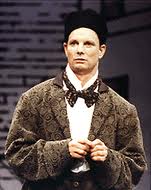 It’s gotten to the point where hearing about how fed up people are about the decline of arts reviews in the press is becoming boring and not helpful in terms of finding a solution to replace the loss.
It’s gotten to the point where hearing about how fed up people are about the decline of arts reviews in the press is becoming boring and not helpful in terms of finding a solution to replace the loss.
“I miss newspapers,” gripes Ron Evans in a recent blog post on the Arts Marketing Bog Salon. “No, I know we still have some daily, weekly, and other newspapers around the country (and my hat goes off to those still working in this field. I also miss hats). But the decline of arts journalism has been massive over the last few years. There are only a few newspapers left in the country that have dedicated arts reviewers/writers – writers who can be trusted to at least publicly declare that they continue to follow journalistic standards. And that’s sad. It’s sad, because nothing good has risen up to replace them.”
I heard a similar cri-de-coeur this morning in a phone interview with the head of a cabaret organization in New York, who blames the loss of media coverage as playing a major role in killing off cabaret as an art form and cabaret venues. And I feel like I hear or read similar complaints every day.
People have been voicing such laments for about a decade now. Chafing at this point isn’t going to bring back full-time arts critics at all the newspapers. It won’t even bring back the newspapers. The fact is that the media landscape is irrevocably changing and we need to look to new alternatives for trusted, engaging writing and thinking about the arts. The blogosphere is full of people who aren’t trustworthy as commentators. But I don’t think it’ll be long before trustworthy commentators rise to the top. It just takes time and patience for this to happen.

 I just got the following email from a friend about In the Red and Brown Water, the first part of The Brothers/Sisters Plays, a trilogy of dramas by Tarell Alvin McCraney (pictured). The trilogy is currently being rolled-out in three Bay Area theatres:
I just got the following email from a friend about In the Red and Brown Water, the first part of The Brothers/Sisters Plays, a trilogy of dramas by Tarell Alvin McCraney (pictured). The trilogy is currently being rolled-out in three Bay Area theatres: I’ve devoted several episodes of
I’ve devoted several episodes of  A few months ago, following a trip out to Orinda to see G B Shaw’s Mrs Warren’s Profession at the
A few months ago, following a trip out to Orinda to see G B Shaw’s Mrs Warren’s Profession at the  As a theatre critic, I generally have a policy that if I find myself feeling negative about the work of a single company over several shows, I’ll give seeing productions by that company a break and then go back and check another show out after some time has elapsed. This helps to “reset the clock” so to speak. There’s no point in harping on over and over again about how terrible one organization’s work is. That gets dispiriting and discouraging for readers and writer alike. It tends to annoy the artists too.
As a theatre critic, I generally have a policy that if I find myself feeling negative about the work of a single company over several shows, I’ll give seeing productions by that company a break and then go back and check another show out after some time has elapsed. This helps to “reset the clock” so to speak. There’s no point in harping on over and over again about how terrible one organization’s work is. That gets dispiriting and discouraging for readers and writer alike. It tends to annoy the artists too.  1. More opera websites should provide information about their choruses. Notices about auditions and lists of singers don’t provide enough detail about how these important musical organizations work. I’d like to see opera websites publishing information about the history and development of their choruses, important milestones in their pasts, production photos, information about life backstage for chorus members and what it’s like to audition and rehearse with an opera chorus. I say this because I just recorded a
1. More opera websites should provide information about their choruses. Notices about auditions and lists of singers don’t provide enough detail about how these important musical organizations work. I’d like to see opera websites publishing information about the history and development of their choruses, important milestones in their pasts, production photos, information about life backstage for chorus members and what it’s like to audition and rehearse with an opera chorus. I say this because I just recorded a